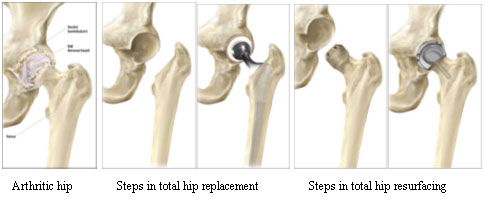BEFORE THE SURGERY
What tests and precautions are required before planning a hip replacement surgery?
It is important to have good quality X-rays of the hip. These allow an assessment of the extent of the arthritis and the deformities like shortening, and to plan out the surgical procedure. It may be necessary to do MRI scanning of the hips especially in cases of avascular necrosis (AVN) before planning a hip replacement surgery. Before the surgery is performed certain tests (blood tests, chest x-ray and ECG) are performed to assess the patients’ general health. In individual cases certain other investigations may be necessary. Blood grouping and cross-matching is done for possible blood transfusion. Assessment by a Physician (Internist) may be necessary especially in the elderly patients and in patients with other medical problems.
Patients who are on blood thinning medication (Warfarin, Aspirin), anti-platelet agents (Clopidomide) and anti-inflammatory drugs (pain killers) will need to stop these tablets some days before surgery to reduce the amount of bleeding. Patients who smoke should stop smoking at least a week before surgery. Patients may be admitted to the hospital one or two days before surgery.
THE SURGERY ITSELF
What type of anaesthesia is used for this surgery?
Generally hip replacement surgery is performed under spinal or epidural anaesthesia (injection in the lower back). With this anaesthesia patients are conscious during surgery but will be completely pain-free in the legs. In certain cases patients may be given general anaesthesia. The type of anaesthesia chosen for a given patient depends upon the patient’s general condition, co-existing medical problems and patient’s personal preference.
How is the Surgery performed?
Surgery is performed using a longitudinal incision (cut) over the hip on the side. The length of the incision varies from 8 to12 cm. The hip joint is exposed by cutting or splitting through the gluteal muscles (muscles of the buttock). The arthritic bony surface of femur head is removed either by cutting through the femur neck (as in conventional hip replacement) or re-shaped preserving the femur head (as in hip resurfacing). The acetabular socket is reamed (using powered grinding instruments) to remove the arthritic surface. In a cemented hip replacement the components are fixed in the acetabular socket and the femoral shaft respectively using bone cement. In case of an uncemented hip replacement, the components are tightly impacted in bone (interference fit) without using cement. The wound is thoroughly washed and a drainage tube is inserted before closure.

Will there be a lot of pain after Surgery?
Some amount of pain is expected after any surgical procedure especially in the first 24-48 hours after surgery. Therefore pain is managed aggressively during the first few days after knee replacement surgery to ensure that the patient is pain free.
The surgery itself is painless as it is done under anaesthesia. Surgery is usually performed using epidural or spinal anaesthesia (which is given in the lower back) or under a general anaesthetic depending upon the patient’s general condition, existing medical problems and patient’s personal preference. During surgery most patients will receive a peri-articular injection (injection given in the soft tissues around the knee) consisting of local anaesthetic and analgesic. After surgery pain medication is continuously administered either through the epidural catheter (a very fine tube placed in the lower back) or intravenously (through patient’s veins) using an automated pump which delivers the required amount of pain medication to the patient. Oral pain medication is also started as soon as patient starts taking oral feeds. With a combination of these methods patients can expect a pain-free post-operative recovery.
What is the immediate post-operative course?
Immediately after the surgery patients are transferred to their regular ward. In some cases it may be necessary to monitor the patient’s general condition in the Intensive Care Unit (ICU or HDU). Patients are allowed to take oral feeds after a period of 4-6 hours after surgery. Patients will have a drainage tube inserted in the hip wound for draining blood out of the wound. This is generally removed after 24-48 hours.
AFTER THE SURGERY
Post-operative Rehabilitation
Patients will be started on calf muscle exercises immediately after surgery to prevent clot formation in the legs. Most patients will be able to stand and start taking a few steps using a walker on the 2nd or 3rd day after surgery. Patients who have had an uncemented hip replacement may be advised to avoid taking full weight on the operated leg for a few weeks. Patients are started on muscle strengthening and straight leg raising exercises . Patients are also trained in stair climbing and using a commode during their hospital stay. The post-operative hospital stay varies from 5 to 7 days depending on the general health of the patient, progress of rehabilitation and the amount of support available to the patient at home.
Skin stitches or staples are removed after 12-14 days post-op in the out-patient clinic. Most patients are able to walk without any walking aids by 4-6 weeks. Elderly or frail patients may need a walking stick for a longer period of time. The maximum achievable hip range of motion and muscle strength is usually achieved by 6-8 weeks. Complete recovery from the operation involving return to full normal function may take 2-3 months and some patients notice a gradual improvement lasting many months longer than that.